This article is more than 5 years old.
This ABCs blog post was written by Nancy Sullivan, Volunteer in Special Collections & Archives.
J is for…
Joseph Severn
It is our mission at ZSR Special Collections & Archives to share the multilayered stories about the myriad of things in our collections. We strive to help all our visitors find that heretofore unknown nugget of information that they are searching for. This blog post exemplifies how a ZSR researcher landed upon his desired unknown nugget, and how that nugget now enables us to present “the rest of the story” to you, our readers and researchers!
First let’s rewind to September of 2014, when archivist Rebecca May wrote a blog post introducing us to painter, Joseph Severn. We learned of Severn’s devoted friendship with British romantic poet, John Keats, and their 1820 voyage from England to Italy, which would prove to be Keats’s final journey. During the trip, Severn, an English portrait and subject artist, recorded details of the trip with watercolor images of scenery he witnessed as the ship, the Maria Crowther, slowly made the journey along England’s southeastern coastline. Three of these Joseph Severn’s paintings have been a part of ZSR Special Collections & Archives since 1958, and it was the 2014 blog post that gave us our first introduction to Joseph Severn, his paintings, and the circuitous route of ownership taken before the paintings found a home at Wake Forest.
Now we fast forward to 2017, and happily we can present you with new and previously unknown information about Joseph Severn’s paintings. Thanks to Severn scholar and researcher Dr. Grant F. Scott and ZSR archivist Rebecca May, we can share “the rest of the story”. Scott, a professor of English at Muhlenberg College in Allentown, Pa., was one day doing internet research for another Severn project, when he landed upon the ZSR link for our three digitized Severn paintings. Immediately Scott realized he had never seen these Severn paintings, and he felt certain the paintings had never been published nor written about. Scott writes,
the rediscovery of three of Joseph Severn’s watercolours from his 1820 journey to Italy with Keats provides an important visual counterpart to his [Severn’s] famous journal-letters. Together with a number of other sketches he [Severn] made on board the [ship] Maria Crowther, these works offer us a new perspective on the voyage.
According to Dr. Scott “this visual evidence has largely escaped notice because it has remained … in special collections, archives and private collections, or if known, has been scattered over the years in a wide variety of publications.” Receiving scans of the ZSR paintings, Scott did “a quick inspection” and his subsequent search revealed that the ZSR watercolors had not been previously published or mentioned in biographies or criticism of the two men.
Scott carefully describes the paintings giving us new insights into the geographic locations for each painting. He writes,
the three watercolours, two of which clearly represent the southwest coast of England, are each pasted to a single sheet of light blue backing paper … The first sketch at the top left of the sheet measures 11.2cm × 18.5cm and is inscribed by Joseph Severn in pencil with the following words: ‘Sandwich Bay / Dorsetshire / These & previous ones done on the / way to Italy with Keats –’. At the top right Severn wrote the word, ‘passing’, followed by a tiny sketch of a ship. Scott goes on to point out, “unfortunately, Severn misidentified the location. There is no Sandwich Bay in Dorset or on this part of the southwestern coast of England, though such a place does exist in Kent, between Ramsgate and Deal, which the Maria Crowther would have passed earlier in the voyage. It is more likely he was sketching Swanage Bay or even Chapman’s Pool in Dorset, which is characterized on its west side by grassy cliffs. His error suggests that he inscribed and identified this sketch at a later date and that in his memory he may have transposed Sandwich Bay with another location along the Dorset coast.
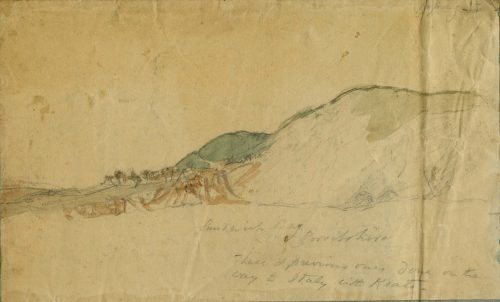
The second, lightly water coloured drawing measuring 11.2cm × 18.6cm bears the following pencil inscription in Severn’s hand: ‘Handfast Point Dorsetshire / Studland Bay’. It depicts a tranquil bay, a bank of lush greenery in the foreground, and two prominent hills with what look like stone fortifications in the distance. By contrast with the first sketch, this description is entirely accurate and presents no immediate difficulties with identification. The visual orientation is eastwards as the Maria Crowther makes its way slowly down the coast. The sketch clearly depicts the famous chalk cliffs, several of the Old Harry Rocks, and in the background the fine detail of two sailing vessels entering Studland Bay.
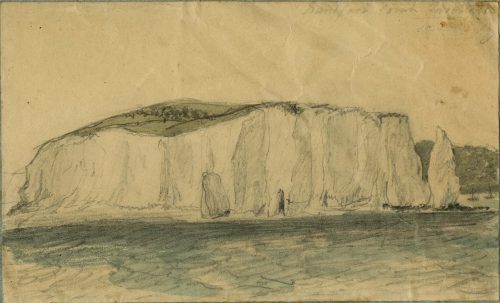
Scott continues with a description of the third and
the most finished of the three watercolours, which measures 12.8cm × 22.2cm … bears no inscription and is for this and other reasons the most enigmatic. It depicts a tranquil bay, a bank of lush greenery in the foreground, and two prominent hills with what look like stone fortifications in the distance. To the right of these hills we may be able to detect a line of small cliffs, perhaps composed of chalk, which gradually transition into the strand of an oval-shaped beach. Because these cliffs stand at such a distance in the perspective of the picture it is not clear whether they are composed of chalk or, for that matter, qualify as cliffs at all. Similar optical ambiguities are presented by the promontories farther to the left. Has Severn depicted a church on the smaller hill and a lighthouse on the larger? It is hard to tell.
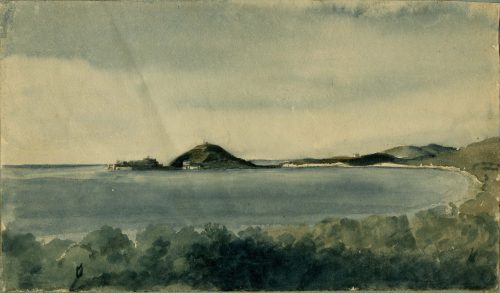
Scott’s research on the ZSR Severn paintings was aided by archivist Rebecca May, and the two were able to more accurately decipher the pencil inscriptions seen on the front of two of the paintings and on the rear of the blue sheet paper the three paintings are mounted on to. It was determined the inscription written on the rear of the blue mounting paper was done by one of Joseph Severn’s sons, Arthur Severn, which says, “given to Maureen Watson / by Arthur Severn RI / 1923 / son of Joseph Severn / (Keats friend).” Within Scott’s detailed writings revealing his findings, he further describes a tale of ownership that is equally as captivating as the details and history of the paintings themselves. The threat of a Nazi invasion into western Europe resulted in the movement of the paintings by Lady Watson (introduced in the 2014 blog post) from England to Ireland to South Africa, to Asheville, NC to Raleigh NC before they finally made it to their present home at ZSR Special Collections.
The accidental discovery of the paintings by Scott and the in depth research he did on our Severn paintings ultimately enabled Scott to share his findings with ZSR. Scott’s thorough article reveals the significance these rarely before seen paintings play within the Severn / Keats story.
A “full circle story” such as this one proves our ZSR collections really are alive and well, and with the help of shared findings from researchers and readers such as yourselves, we can more easily offer “the rest of the story” to the world. We encourage you to explore our diverse collections be it for research, relaxation, or education. You are invited to come to our Special Collections and Archives Reading Room or dive into our digital collections from the comfort of your home or office. Either way you do it, you will find our shelves chock full of historically significant nuggets each filled with intrigue and mystery! We hope you will help Special Collections and Archives by sharing your findings with us, and in turn we will be able to share “the rest of the story” with others.
J is for … John Pennel “Civil War Letters”
These three letters were penned by Corporal John Pennel as he served as a Civil War soldier in Company B, 2nd Regiment of the North Carolina Cavalry. Pennel was born in Wilkes County, NC in 1843, and he enlisted in the Confederate Army May 31, 1861 in Wake County, NC at the age of 18. He was “mustered in as Corporal” and this collection consists of three letters Pennel wrote to his parents during his time in the service.
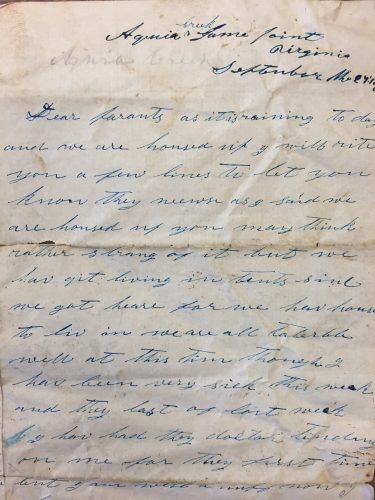
Pennel’s first letter is dated “September the 27th ___from Aquia Creek ___, Virginia.” It was possibly written in 1861 based on the battle dates of May 29th – June 1, 1861 for the Battle of Aquia Creek. This historic overview of the Battle of Aquia Creek gives the following information about this battle location:
Beginning in the fall of 1861 and continuing until early March 1862, the Confederates blockaded the Potomac River. The main offensive batteries were upstream from Aquia Landing at Freestone, Cockpit, and Shipping Points, and in the vicinity of Evansport, Virginia. Eventually the CSA George Page moved to Quantico Creek. During this time, Aquia Landing continued to be defended but was a secondary position. When the Confederates retreated in March of 1862, they burned the Aquia Landing wharf and destroyed the RF&P Railroad. Soon after the Confederate retreat the Federal Army rebuilt the wharf and railroad and used Aquia Landing for a supply depot through August 1862, at which time they evacuated the area in response to their defeat at the Battle of Second Manassas (Second Bull Run) and first Confederate invasion of Maryland.
Pennel’s descriptions of his battery location and the cannon drills where he is a “bomb toater and ball toater” make me think he was in Aquia Creek during the fall of 1861 as the Confederates held the Potamac River closed to Union Naval traffic. It appears Pennel is thinking of the upcoming winter when he writes, “Tell Mother and Clar I meant them to knit me two or three pare of socks and make me a pare of pant and line them so they will be warme and send by … I want colord cloth but stripes on them … same safe hand and I want you to get me two or three boushels of dried fruit and bring them I want number eights long legs high in the insteip thick botems”.
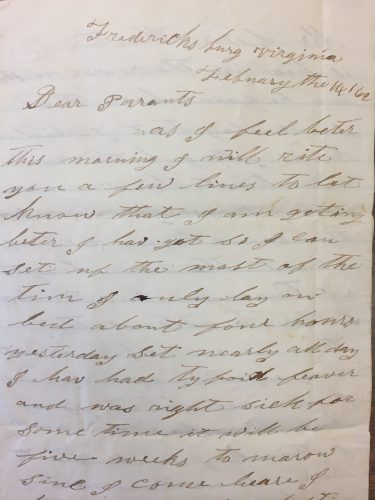
John Pennel’s second letter within this collection is marked Fredericksburg, Virginia, February the 14, ‘62. Pennel tells “I have had tyfoid feaver and was right sick for some time”. He was moved to a home in Fredericksburg where he spent five weeks recovering from his illness, and he states this home is “one of the best places to stay that could be” and “they lady of the house is equal to a mother to me”. He describes his appetite “is very good … I can eat plenty foray body that has been sick”. His plan is to “start home some time next week if no back set”. “We will start as soon the doctor think we are able to stand the trip”. It is hard to imagine this recovering soldier having the strength to travel from Fredericksburg, Virginia to his home in Wilkes County, North Carolina.
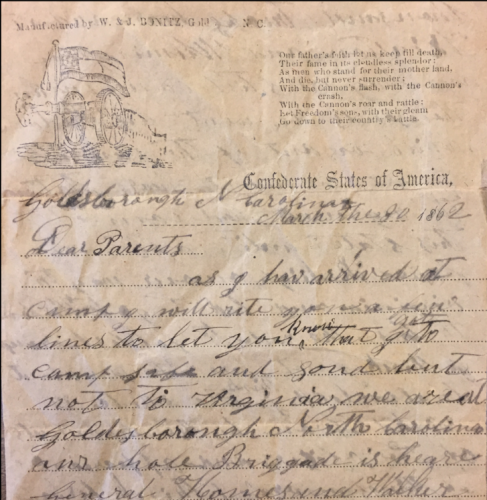
In the third and last letter of this collection, dated March 30th, 1862, Pennel writes from his camp in Goldesborough, North Carolina where “our hole Briggade is heare … General Hornes and Walker are both here”. He tells “there is about forty thousand troops heare and at Kinston and Wilmington and they are still comeing by thousands”. In getting to this camp “we wet by Weldon which was out of the way right smart … we didn’t heare that the regment had come to this state until after we passed Raleigh on our way to virginia … they boys hav been seeing hard times without tents or any think to eat for four or five day”. From both the second and third letters the reader certainly gains an appreciation for the soldiers’ physical hardships as well as the geographical distances covered on foot and/or on horseback during the war.
In our world of instant text communication, it is fascinating to read Pennel’s take on the spread of Civil War news when he writes “you can heare more ware news thare than we can heare at this place”. He goes on to state “at present everything is very still at this tim but grat preperations are being made”. In closing, Pennel mentions acquaintances known to him and his parents, and he states “they are all swell and doing well this leaves me well Your son John Pennel”.
According to his service record which is also a part of this collection, Pennel continued to be “present or accounted for” in the Army until he was killed in action at Chancellorsville, Virginia, May 3, 1863 at the age of 20.
J is also for Jehu L. Shuck
The Triennial Convention of the National Baptist Denomination sent Jehu Lewis Shuck to China in 1835, making Shuck the first American Baptist missionary sent to that foreign land. Shuck, who was born in 1814 in Alexandria, Virginia, was surely impacted during his early life by the founding of the national Baptist denomination in 1814 and he must have heard the stories being told in church “of the heathen far and wide in this land”.
The new Baptist denomination had made it their focus to advance missionary work in the world, and it was during their 1835 convention that 23 year old Shuck made a defining step that would prove life changing. According to a biography of Shuck’s life from Boston University School of Theology, Shuck attended the convention, and at the time an offering for foreign missions was collected, “he could not give silver or gold to the mission cause so he gave himself.” Shuck dropped a slip of paper into the offering plate and on the paper he had written “I give myself.” It was here Shuck was appointed to missionary service and this appointment made Shuck the first Baptist missionary to be sent to China.
On September 10, 1835, he was set apart as a missionary to China, in the First Baptist Church, Richmond, Va., and on September 22nd, 1835 he sailed aboard the Louvre making his journey to China. Shuck and his wife, Henrietta, arrived in Macao in 1836, where they lived and worked until the end of the Opium War (1839-1842).
The Shucks then moved to Hong Kong and a year later organized the first Baptist church there. While her husband was involved in evangelizing and publishing, Henrietta opened a school for Chinese children and began taking Chinese orphans into her home, a practice she had begun in Macao. In Hong Kong the number grew to thirty-two children whom the Shucks fed, clothed, and nurtured. In 1844 Shuck’s wife died in childbirth at the age of 27, and Shuck left China on furlough to return to the US. Upon his return, Shuck found the 1845 Triennial Convention in dispute over slavery and missions policies. It was at this time Baptist churches in the South separated from the Triennial Convention, establishing the Southern Baptist Convention. Shuck affiliated with the newly formed Southern Baptist Convention Foreign Mission Board and married for a second time. In 1846 the Board assigned Shuck as a missionary to Canton, China, and by 1847, Shuck was transferred to Shanghai.
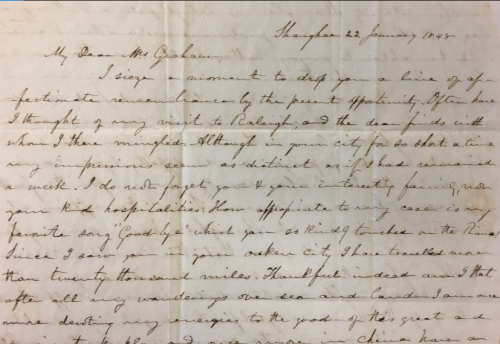
It is here the ZSR Special Collections and Archives letter composed by Shuck fits into the timeline of Shuck’s missionary work in China. Dated January 22, 1848, Shuck had returned to Shanghai (spelled Shanghae throughout the letter) China from a visit to the US, where he had visited with Mr. and Mrs. William Alexander Graham of Raleigh, North Carolina. It is to Mrs. Graham that Shuck writes his letter. Shuck graciously thanks Mrs. Graham for her family’s hospitality and he states “since I saw you in your oaken city I have traveled more than twenty thousand miles. Thankful indeed are I that after all my wonderings over sea and land I am once more devoting my energies to the good of this great and ancient people” …. And “I am every way better pleased with Shanghae than with Canton”. He describes the climate of Shanghae as “delightful Missionaries, with due care and judiciousness and the masters blessings, will be able to enjoy better health here than any where less in the East.”
He says, “ as a mission our prospects are ___ encouraging, God we trust will make us useful here. Pray for us. The North Carolina churches are well represented in Shanghae by Bro and Sis. Yates. In all my missionary life I have not met with more lovely Christians, more devoted missionaires.” It is of particular interest to note Matthew Tyson Yates was a graduate of Wake Forest Academy and College where he received a B.A. in 1846 and worked with Shuck as a missionary in China starting in 1847. Tyson remained in China carrying out his missionary work for 42 years. He and his wife died and were buried in Shanghai. The M.T. Yates papers are a part of our Special Collections and Archives.
Shuck gives the reader insight into his founding of a Baptist Church in Shanghae by saying “we have commenced holding religious services in the Shanghae dialect, and though our beginnings are feeble indeed our services promise to be interesting.” Pastor to “only ten practical Christians” who are “punctual at all the meetings, praying in their families & actively trying to do some good …” Shuck proceeds to make certain Mrs. Graham knows “Missionaries in far off heathen lands expect their brethren at home to remember them in a special manner at least once a month.” Shuck clearly wants Mrs. Graham to feel “We have descended into the well, you at home must hold the rope.”
As the letter continues, Shuck departs from his descriptions of his work and shifts to “pray make my compliment to the Governor” (this title Shuck used to refer to William Alexander Graham, husband of Mrs. Graham). The word for Governor is Choong took.” Shuck says. He proceeds to describe the imperial Chinese government as he details China as having “18 provinces, 8 governors …and 18 Lieut. Governors”. He tells of the present Emperor, Taou Revang, and his age of “about 60 years”. Shuck then issues kind salutations and signs his letter “Faithfully yours, J. Lewis Shuck”.
According to his biography, Shuck remained in China until November 1852, at which time he left China for the last time. During his 17 years in China, Shuck had begun three churches, built four chapels and a school, baptized at least forty Chinese converts, and written and published thirteen works in Chinese languages. After arriving back in the United States in 1853, he resigned from the SBCFMB (the Southern Baptist Convention Foreign Mission Board), to accept an appointment by the Southern Baptist Convention Domestic Board as a missionary to the Chinese in California. In 1855, he organized in San Francisco a Chinese-speaking Baptist church, the first in the United States. He retired to Barnwell, South Carolina, in 1861 and died shortly thereafter at the age of 49.
Stay tuned for K…
If you would like to schedule an appointment to view any collections in Special Collections & Archives, please email archives@wfu.edu.

4 Comments on ‘ABCs of Special Collections: J is for…’
Wonderful research, assisting researchers and information. Thanks for all you have done to bring our collections into view for a wider audience.
Congratulations for this excellent work and presentation of the information.
The Joseph Severn watercolors give me goosebumps–just knowing they were in the presence of Keats!
Thank you for bringing these treasures to light and giving us , “the rest of the story”.